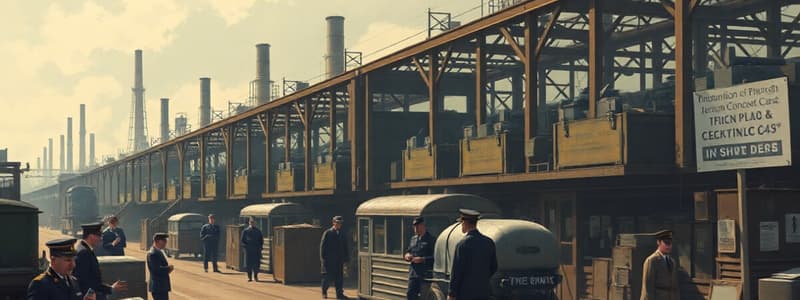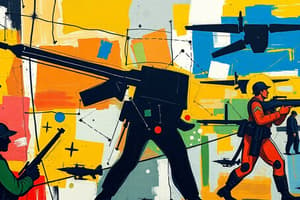Podcast
Questions and Answers
What was the primary purpose of the Bracero Program?
What was the primary purpose of the Bracero Program?
- To establish a standardized wage system for migrant workers across the nation
- To provide temporary relief to a labor shortage, particularly in the agricultural sector (correct)
- To prevent the exploitation of Mexican workers by American employers
- To offer opportunities for Mexican citizens to gain permanent residency in the United States
Which of the following accurately depicts the conditions faced by Bracero workers?
Which of the following accurately depicts the conditions faced by Bracero workers?
- Bracero workers were primarily forced into involuntary labor, lacking any personal agency.
- Bracero workers faced discrimination and exploitation, but also saw opportunities. (correct)
- Bracero workers were given the same rights and privileges as American citizens.
- Bracero workers were provided with excellent living conditions and pay.
How did the Second World War impact the US labor market?
How did the Second World War impact the US labor market?
- The war led to a decrease in the number of available jobs as most industries shut down.
- The war led to the closure of factories and shipyards, causing widespread unemployment.
- The war generated new opportunities for women, leading to their increased participation in the workforce. (correct)
- The war resulted in an increase in unemployment due to the large number of men leaving for military service.
Which of these factors contributed to the increased migration of African Americans from the South to the North during the Second World War?
Which of these factors contributed to the increased migration of African Americans from the South to the North during the Second World War?
What is meant by "Rosie the Riveter" being a "fictional icon?"
What is meant by "Rosie the Riveter" being a "fictional icon?"
How did the American public view the war effort during the Second World War?
How did the American public view the war effort during the Second World War?
What impact did the Bracero Program have on the Mexican presence in the United States?
What impact did the Bracero Program have on the Mexican presence in the United States?
What significant shift did American industries make during the war?
What significant shift did American industries make during the war?
Which of the following was a method implemented to ensure adequate supplies for troops?
Which of the following was a method implemented to ensure adequate supplies for troops?
What type of gardens did Americans grow to support the war effort?
What type of gardens did Americans grow to support the war effort?
How did the federal government finance the war effort?
How did the federal government finance the war effort?
What was a major change in tax policy during the war?
What was a major change in tax policy during the war?
What impact did the war have on unemployment in the United States?
What impact did the war have on unemployment in the United States?
Which group saw an increase in job opportunities during the war?
Which group saw an increase in job opportunities during the war?
What materials were Americans encouraged to recycle during the war?
What materials were Americans encouraged to recycle during the war?
Flashcards
War Production Board
War Production Board
A U.S. federal agency that organized wartime industrial production.
Arsenal of Democracy
Arsenal of Democracy
Roosevelt's pledge that the U.S. would supply armaments during WWII.
Rationing
Rationing
Controlled distribution of scarce resources during WWII.
Victory Gardens
Victory Gardens
Signup and view all the flashcards
War Bonds
War Bonds
Signup and view all the flashcards
Income Tax Expansion
Income Tax Expansion
Signup and view all the flashcards
Deficit Spending
Deficit Spending
Signup and view all the flashcards
Full Employment
Full Employment
Signup and view all the flashcards
Rosie the Riveter
Rosie the Riveter
Signup and view all the flashcards
Bracero Program
Bracero Program
Signup and view all the flashcards
Mexican migration during WWII
Mexican migration during WWII
Signup and view all the flashcards
Impact of WWII on women
Impact of WWII on women
Signup and view all the flashcards
Military service in WWII
Military service in WWII
Signup and view all the flashcards
Challenges of war
Challenges of war
Signup and view all the flashcards
Discrimination in Bracero Program
Discrimination in Bracero Program
Signup and view all the flashcards
Effects of military service
Effects of military service
Signup and view all the flashcards
Study Notes
Wartime Economic and Social Changes in America
- Wartime Economy: The federal government directed the American economy through the War Production Board, overseeing industrial output.
- Industrial Restructuring: Businesses, big and small, converted their factories to produce war materials. Automobile manufacturers shifted to making airplanes, tanks, and trucks; appliance and toy makers produced medical supplies, ammunition, and other necessary equipment.
- "Arsenal of Democracy": The U.S. became a huge military producer, surpassing all its enemies combined. Output included 7,400 ships, 88,000 tanks, 300,000 airplanes, 2.4 million trucks, 6.5 million rifles, and 40 billion bullets.
- Rationing: The U.S. government implemented rationing of gasoline, fuel oil, cloth, shoes, sugar, meat, dairy, coffee, and cooking oil using ration cards and stamps.
- Victory Gardens: Americans planted "victory gardens" to increase their own food production and supplement rations.
- Recycling Campaigns: Citizens collected scrap metal, rubber, clothing, and paper to contribute to the war effort.
- War Bonds: Eighty-five million Americans purchased war bonds to fund the war.
- Increased Taxes: Congress expanded the income tax to apply to most Americans and raised tax rates on the wealthy, implementing a payroll deduction system
- Deficit Spending: The government used massive borrowing (deficit spending) to finance the war.
- Full Employment: The war ended the unemployment problems of the Great Depression, leading to full employment.
Wartime Labor Shortages and Opportunities
- Mobilization of Men: Millions of men were enlisted in the armed forces, creating a surge in labor demands.
- New Opportunities for Women: Women filled vacant industrial jobs previously held by men, working as factory workers (like "Rosie the Riveter"), welders, riveters, mechanics, and more.
- African American Migration: African Americans continued moving from the rural South to industrial North in search of jobs.
- Bracero Program: The U.S. government contracted Mexican workers to fill agricultural and railroad labor shortages (Bracero Program). This agreement secured five million contracts across twenty-four states between 1942 and 1964.
- Discriminatory Policies & Bracero program: Discrimination against Mexican Workers prevented participation in the Bracero program in Texas until 1947
Wartime Society and Military Experience
- United States Military Service: More than 16 million Americans served in the military; a significant proportion were enlisted, others were drafted.
- Military Propaganda: Newsreels depicted brave and glorious combat efforts and soldiers, sailors, and marines.
- War's Aftermath: Millions of Americans were wounded or suffered psychological trauma, and over 400,000 lost their lives in the war.
Studying That Suits You
Use AI to generate personalized quizzes and flashcards to suit your learning preferences.




